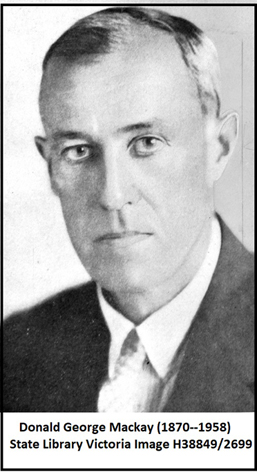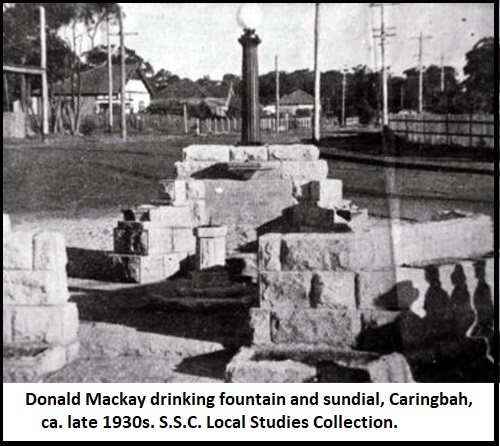
 The last
of the great Australian explorers
The last
of the great Australian explorers
Donald George Mackay, F.R.G.S., O.B.E.,
a man who shunned publicity, was one of the most notable yet least known
Australian personalities of the 20th century, the son of one of the
pioneers of inland settlement in New South Wales. He was born on 29 June 1870 at
Yass, New South Wales, the fourth child and second son of Alexander Mackay,
owner of Wallendbeen station, and his wife Annie, nee Mackenzie, both Scottish
born.
Donald
was educated at home by a governess, then at Wallendbeen Public School
and at Oaklands School, Mittagong. At age seventeen, he was apprenticed to an
engineering firm in Sydney but, unhappy at that job, he soon returned to his
father’s property, Wallendbeen, to work as a jackeroo. The bush and the outback
were more to his liking.
After
his father’s death in 1890, Donald inherited a substantial income which allowed
him to travel extensively throughout the world including New Zealand, Japan, and
Europe. He lived life full of varied adventures one of which was gold
prospecting in western New South Wales.
On
29 July,1899, Mackay set out from Brisbane, with Frank White, to bicycle around
Australia. After White abandoned the ride, he returned to Brisbane on 27 March,
1900, having cycled 11, 000 miles (17,700 kilometres) through little known huge
areas which impressed on him the vastness of the country.
On
16 April, 1902, Donald Mackay married Amy Isobel Little at Burwood, New South
Wales.
They then settled at Port Hacking where fishing, sailing, sculling, hiking and
his speedboat were some of Donald’s interests.
His ambitions for exploration found him, in 1908, with a party leaving
for Papua to investigate the headwaters of the Purari River. During the
expedition, they also -discovered a coalfield.
During
the next decade, Mackay bought a yacht and cruised in the South Seas in search
of hidden treasure.
During his travels, he collected tattoos until he was a walking art
gallery.
Donald
Mackay tried to enlist during World War I but, to his surprise, was declared
medically unfit.
He tried to help the war effort through donations and fund raising
and, after the war, bore the entire cost of the war memorial –
a 36 foot high,
grey granite obelisk -
erected in Wallendbeen to the memory of the men who had served in the
armed forces abroad.
In
1826, Mackay financed and accompanied the first of several expeditions to the
Northern Territory when, with anthopologist Dr. Herbert Basedow, he went into
the Petermann Ranges by camel.
In 1928 they explored
Arnhem Land on horseback.
In 1930, 1933, 1935 and 1937 Mackay financed and led aerial surveys of
Central Australia and discovered a large lake which the government named after
him.
The great possibilities of using aircraft in survey
work were demonstrated for the first time in an attempt to produce accurate maps
of the physical features of the inland.
With flights leaving from three bases – in the Peterman Range,
southeast of Port Hedland at the head of the Fortescue River and the Fitzroy
River - the surveys covered some 560,000 square miles and produced more useful
maps than had previously existed and corrected the few maps that were already in
existence.
Copies of all Mackay’s maps and reports were donated to the Commonwealth
Government and the Mitchell Library, Sydney.
To
commemmorate the successs
of her husband’s 1935 exploration, Amy Mackay presented a unique
memorial to the Sutherland Shire Council – a drinking fountain for all living
creatures.
Designed by Thomas D Esplin and constructed by John (Jack) Connors, of
Caringbah, an inscription from Isiah 55.1, read ’Come ye to the waters’ and
there were separate drinking facilities for humans, small troughs for horses and
dogs, a bird bath and bubblers with a step for small children.
There was a sundial and a bronze pillar supporting a 14 inch diameter
opal lighting ball. Local sandstone was used for the flagging, fountain and
surrounding seats and walls.
The fountain was located at the intersection of Port Hacking Road
(South) and the Kingsway, Caringbah. This was where the local RSL held their
remembrance services on Anzac Day.

However, as Caringbah grew and traffic lights
were planned for this important road junction, it was obvious that the memorial
would have to be moved.
On the recommendation of the Shire Engineer, in 1972,
the memorial was moved to the small park adjoining the Caringbah Hotel.
It was reconstructed in a more simple shape and minus
the horse and dog troughs, the bubbler, the sundial and seats.
The area behind was landscaped and the column was
engraved with the words ‘Lest We Forget’. It is still used on Anzac Day.
In
1934 Donald George Mackay was awarded an OBE and in 1937 was awarded a CBE for
his efforts. He retired to his home on Port Hacking and continued with his quiet
acts of philanthropy, always attending Caringbah Public School for the Empire
Day celebrations.
Shortly after Caringbah RSL was formed Donald learned that a site
was needed on which to erect a second-hand quonset hut.
He offered the
Sub-branch the free use of a block of land he owned on the corner of
Cawarra(then) and Banksia Roads. Some years later, he transferred the land to
the Sub-branch so that the club building could be erected on the site. Although
in poor health, Donald Mackay drove to the site to lay the foundation stone but
did not live to see the building completed.
The RSL asked the council to rename this short street
‘Mackay Street’ to which the Council agreed. For many years, on the Saturday
closest to the 19 September, members would gather at the entrance to the
Memorial Club, near a photograph of Donald Mackay to honour a generous man after
whom the club building was named.
In
1942, the book ‘Last of the Explorers’ by the Australian author, Frank Clune,
was released.
It is the story of a remarkable man, his adventurous life and
pioneering family.
In the book, Donald Mackay paid tribute to his wife,
Amy, who accompanied him on many of his adventures ‘I got a real good sport for
a life mate …..getting married was the most sensible thing I ever did in my
life’.
Donald
George Mackay died at Sutherland Hospital on 17 September 1958 and was cremated
at Woronora Cemetery. His wife, Amy Isobel, died in 1956 and was cremated at
Woronora Cemetery. There were no children of the marriage.
Further information
about the Mackay family can be found in the family tree database on this
website:
MACKAY, Donald George
-- Click on the heading of this story.
MACKAY, Alexander
MACKAY, James Alexander Kenneth
REFERENCES:
-
Australian Dictionary of Biography
-
NSW BDM
-
Ancestry
-
Northern Territory Library
-
Last of the Explorers by Frank
Clune
-
Treasures of the State Library of NSW
by Ann Robertson
-
The Donald Mackay Memorial -- Caringbah
by M Hutton Neve, (Journal of SSH Society
-
Caringbah Sub-branch of Australia and
Memorial Club
-
Pictorial News, 11/9/1084
-
The Propellor,
18/7/1935, 13/8/1942
-
Cootamundra Herald, 13/08/19o4
-
Daily
Advertiser
(Wagga Wagga), 20/11/1935
-
North
West Champion
(Moree, NSW), 21/11/1935
-
The Sun
(Sydney), 19/11/1935
-
The
Queenslander
(Brisbane), 7/4/1900
-
The
The Courier-Mail
(Brisbane), 5/7/1937, 16/7/1937, 11/4/1942
-
The
Sydney Morning Herald
(Sydney), 9/7/1935, 25/3/1942


 The last
of the great Australian explorers
The last
of the great Australian explorers